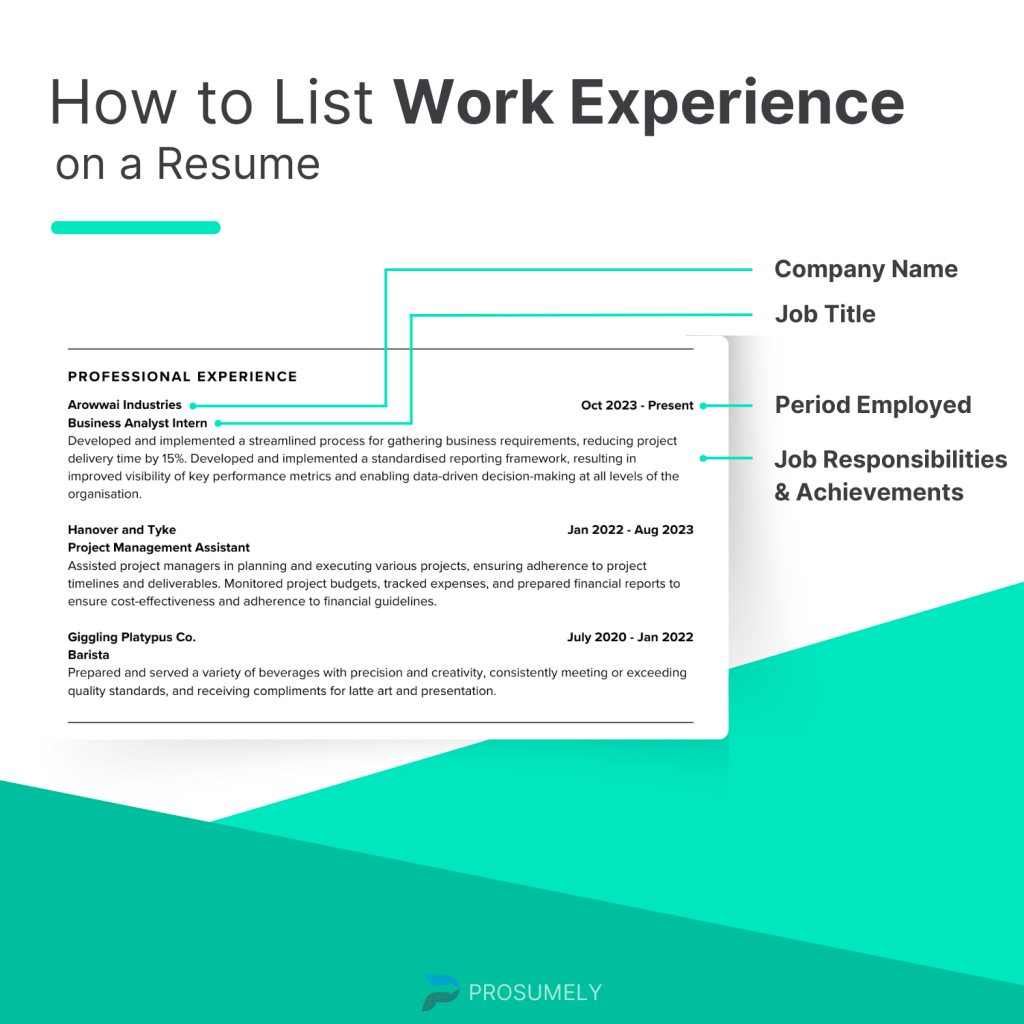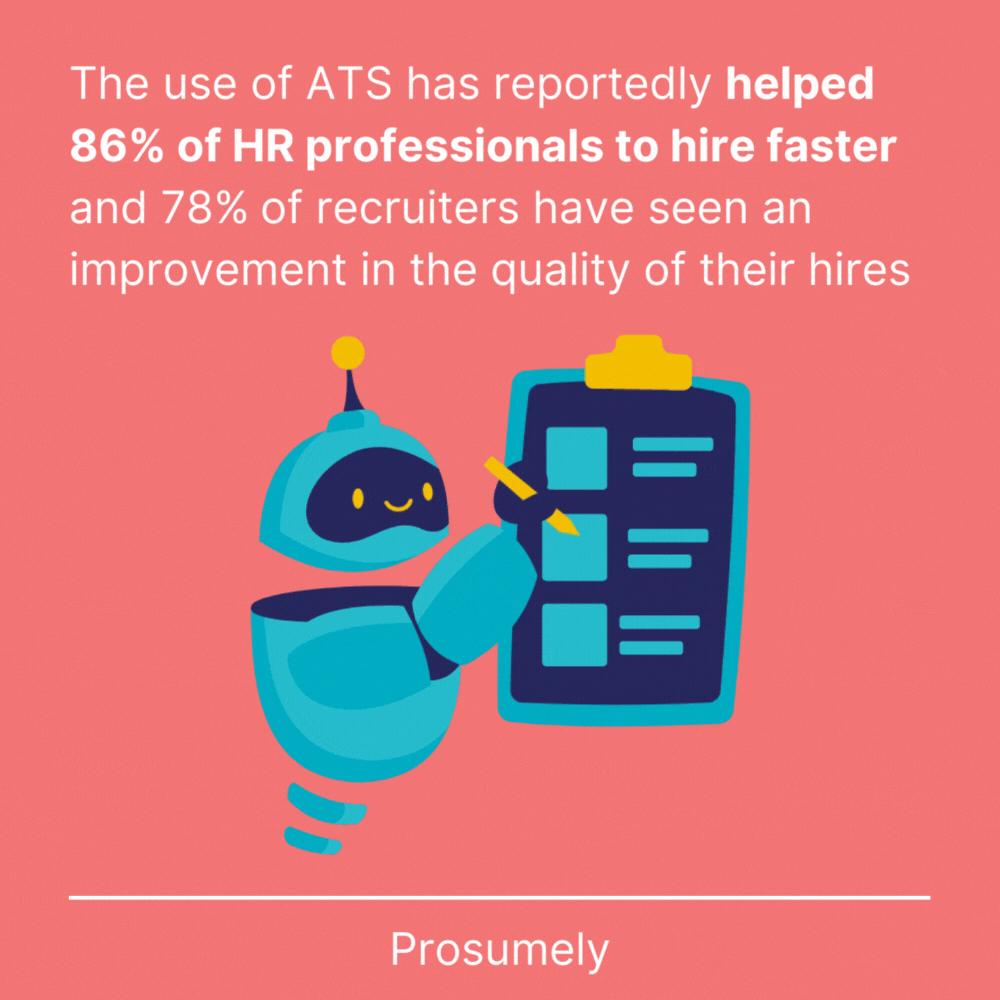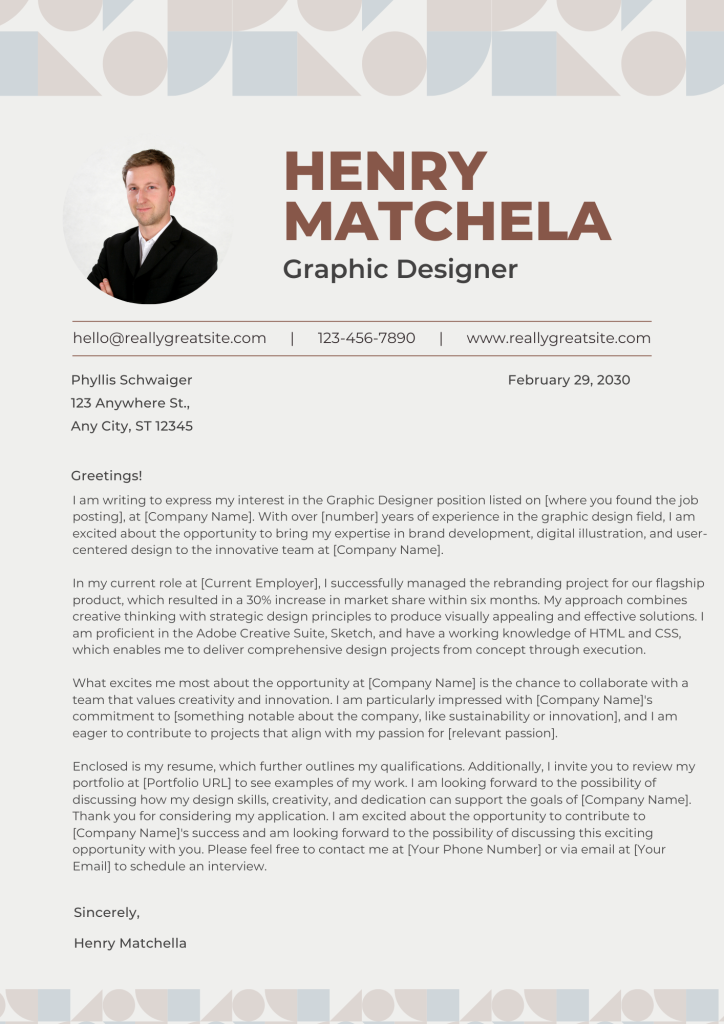Graphic Designer Resume for 2024 | A Complete Guide
12 March | 10 min read

The graphic design landscape is continuously evolving, with new trends, technologies, and job opportunities emerging every year.
As we step into 2024, graphic designers face a competitive job market that demands not only creativity and technical proficiency but also a keen understanding of current trends and digital platforms. This guide provides an in-depth look at how to craft a graphic designer resume that stands out, showcases your skills, and aligns with the expectations of employers in 2024.
Follow the steps in this article to develop a resume that creates an impact on the recruiter:
- Superior Graphic Designer Resume Template (Outshining 90% of Competing Samples)
- Comprehensive Tutorial on Crafting Your Graphic Designer Resume
- Top 25 Essential Skills to Feature in Your Graphic Designer Resume
Get Your Resume Reviewed For FREE!
Our team of HR professionals, Industry Experts and Resume designers will review your CV/Resume
How to Write a Resume
Certainly! Writing a resume as a Graphic Designer requires showcasing both your creative abilities and your professional experience in a manner that captures the attention of potential employers or clients. Here are key points to consider when crafting your resume:
Start with a Compelling Summary or Objective: This should be a brief section that outlines your professional goals, skills, and what you bring to the table as a graphic designer. Tailor this to the specific job or client you’re applying to, highlighting your most relevant qualifications.
Highlight Your Design Skills: Clearly list your design skills, including software proficiencies (Adobe Creative Suite, Sketch, etc.), and other relevant skills such as web design, typography, or animation. Be specific to give potential employers a clear understanding of your capabilities.
Showcase Your Professional Experience: List your work experience in reverse chronological order. For each position, include your job title, the company name, dates of employment, and a brief description of your responsibilities and achievements. Use bullet points to detail specific projects you worked on, the impact of your work, and any recognitions or awards you received.
Include a Link to Your Portfolio: Your portfolio is crucial in a graphic design resume. Make sure to include a link to your online portfolio. This allows potential employers to see your work firsthand and assess your suitability for their projects.
Education and Certifications: List your relevant educational background, including any degrees or certifications related to graphic design. If you’ve taken courses in specific design software or methodologies, include those as well.
Awards and Recognitions: If you’ve received any awards or recognitions for your work, make sure to include these. This can significantly bolster your resume by showcasing your work’s impact and recognition within the industry.
Personalize and Design Your Resume: As a graphic designer, the design of your resume itself can serve as a testament to your skills. Use a clean, professional layout that reflects your personal design style without overshadowing the content. Pay attention to typography, color schemes, and spacing to ensure readability and visual appeal.
Proofread and Get Feedback: Finally, thoroughly proofread your resume to eliminate any errors. It’s also beneficial to get feedback from peers or mentors in the graphic design field, as they might offer valuable insights to improve your resume.
By keeping these points in mind, you can create a compelling graphic designer resume that highlights your strengths and achievements, setting you apart from other candidates.
Graphic Designer Resume Examples
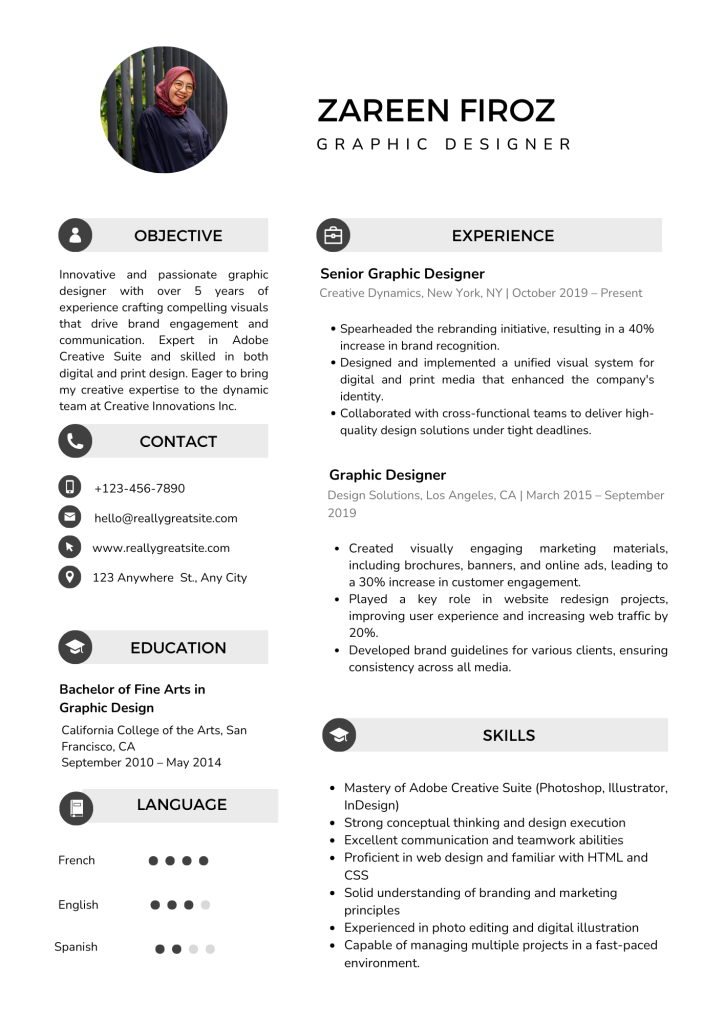
Why you should create your resume from a professional resume writer
Creating your resume with the help of a professional resume writer can offer several advantages, particularly in a competitive job market. Here are some reasons why considering a professional for your resume might be beneficial:
- Expertise: Professional writers craft impactful resumes that highlight your strengths effectively.
- Industry Trends: They stay updated on resume and recruitment trends, tailoring your resume to meet employer expectations.
- Objective View: Professionals offer an external perspective to better articulate your achievements and skills.
- Time-Saving: Outsourcing resume writing frees up your time for other job search activities.
- Customization: They provide personalized resumes, not generic templates, tailored to specific job applications.
- Error-Free: Ensure your resume is free of typos and formatting errors, presenting you professionally.
- Increased Interviews: Professionally written resumes can boost your chances of getting interviews.
Let our Resume Writers Develop your Resume!
✅ A dedicated professional to your CV ✅ ATS optimized ✅ Professionally structured & designed ✅ Free Cover Letter included ✅ Free Cover Email included ⌛ 48hrs delivery promise after payment 📄 Delivered in both PDF & Word format
How To Build Your Graphic Designer Resume in 9 Easy Steps
We’ve provided a glimpse of the ideal outcome.
Next, we’ll guide you through the necessary steps to craft the ultimate graphic designer resume!
#1. The right Resume Format for Graphic Designer
Choosing the right resume format is crucial for a graphic designer, as it can significantly impact how your skills, experiences, and achievements are perceived by potential employers. Here are three common resume formats, along with guidance on selecting the most suitable one for a graphic designer role:
- Reverse-Chronological Format (Ideal for most candidates)
Description: This format lists your work history in reverse chronological order, starting with your most recent position at the top. It allows employers to see your career progression and recent accomplishments first.
Best for: Graphic designer with a clear career progression in marketing or related fields. It’s particularly effective if your recent roles are relevant to the job you’re applying for. - Functional (Skills-Based) Format
Description: Focuses on your skills and achievements rather than your job history. This format groups your experiences under skill categories, making it easier to highlight specific marketing competencies.
Best for: Individuals transitioning into a graphic designer role from a different field, career changers, or those with gaps in their employment history. It’s also suitable for showcasing specific skills relevant to the job. - Combination (Hybrid) Format (Not Recommended)
Description: Combines elements of both the reverse-chronological and functional formats. It allows you to highlight your skills and achievements upfront, followed by a reverse-chronological work history.
Best for: Graphic designer with a robust set of skills and a strong work history. It’s ideal for those who want to showcase both their functional expertise and career progression.
Although each format has its merits, we suggest adhering to the reverse-chronological format. It’s the preferred choice among job seekers and hiring managers alike for several compelling reasons.
Here’s what it looks like:
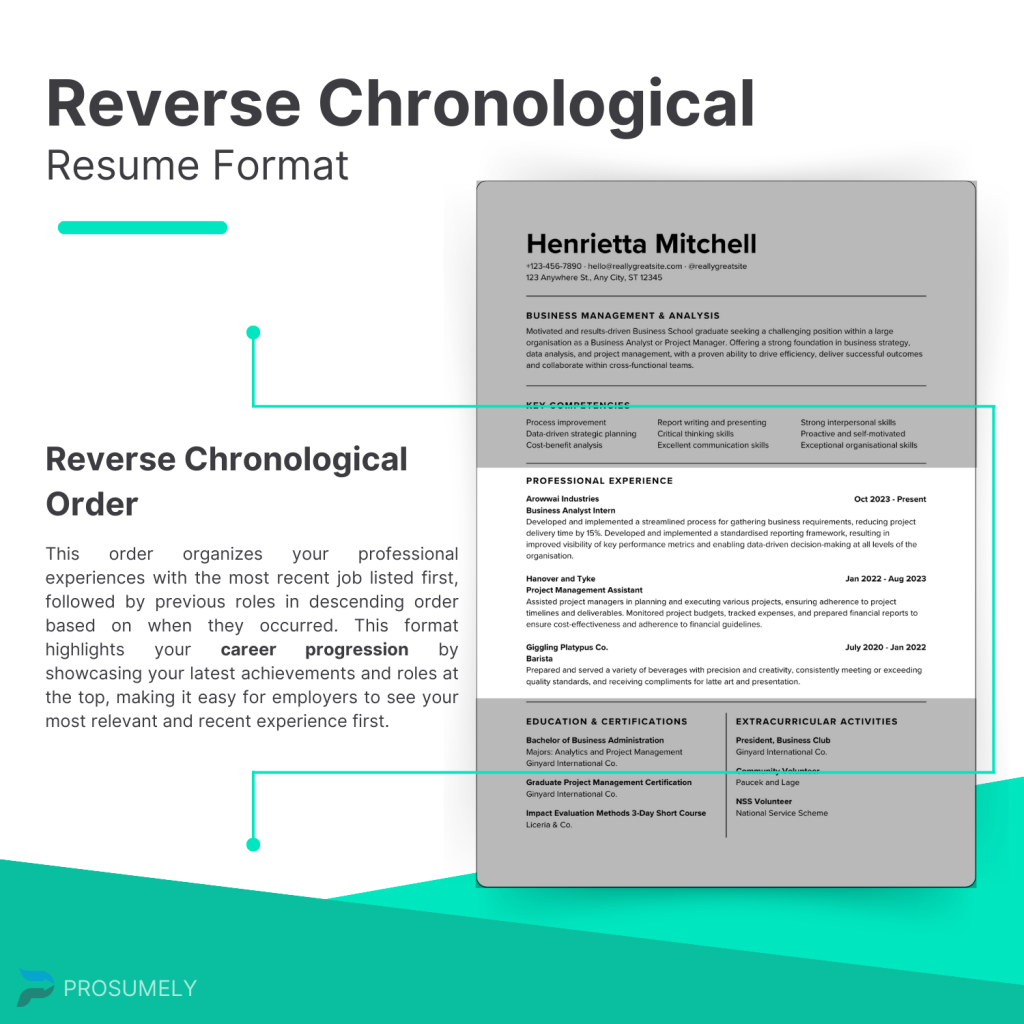
Add Value Preposition to your Resume
Incorporating a value proposition into your resume can significantly enhance its effectiveness by clearly articulating what you bring to the table. A value proposition is a concise statement that highlights your unique value and how it benefits the employer. Here’s how you can add a value proposition to your resume:
- Define Your Unique Selling Points (USPs): Identify what sets you apart from other graphic designers. This could be your creative process, your ability to solve complex design problems, expertise in specific design software, or experience in a particular industry.
- Identify Employer Needs: Research the company and the specific role to understand what challenges they face and what skills are most valued. Your value proposition should address how you can solve their problems or contribute to their goals.
- Craft Your Value Proposition Statement: Combine your unique value with what the employer needs into a compelling statement. This statement should be concise, specific, and focused on outcomes. For example, “Experienced graphic designer with a decade-long track record of executing campaigns that have consistently exceeded lead generation targets by over 30%, driving revenue growth and brand visibility in competitive markets.”
- Position It Strategically: Place your value proposition at the beginning of your resume, often in the summary section. This ensures it catches the employer’s attention right away. Your statement acts as a hook, encouraging them to read further.
- Showcase Results with Metrics: Quantify your achievements whenever possible. For example, mention how your design work increased client engagement by a certain percentage, improved website traffic, or boosted sales. Metrics provide concrete evidence of your impact.
Value Preposition Example for Graphic Designer:
Dynamic Graphic Designer with a proven track record of spearheading successful marketing initiatives that have increased market share by 25% within two years. Specializes in developing innovative strategies that enhance brand visibility, foster customer engagement, and drive sustainable revenue growth. Eager to bring strategic vision and creative solutions to [Company Name], leveraging extensive experience in digital marketing and team leadership to achieve and surpass marketing objectives.
Impactful Career Summary for Graphic Designer Resume
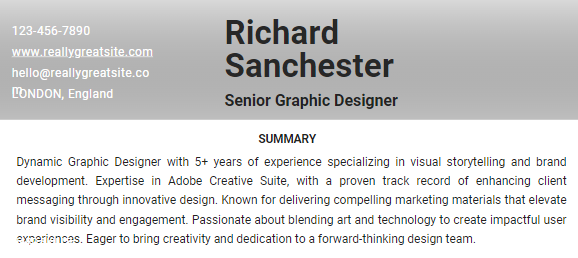
Writing an impactful career summary for a Graphic Designer resume involves succinctly showcasing your most significant achievements, skills, and qualities that make you the ideal candidate for the position. Here’s a structured approach to crafting a compelling career summary:
- Start with Your Title and Experience: Begin with a clear job title to immediately define your position. Follow this with a concise statement about your years of experience and the types of industries or markets you’ve worked in. Example: “Innovative Graphic Designer with over 10 years of experience in the technology and healthcare sectors.”
- Highlight Key Skills: Identify the core skills that make you effective in your role. These could include strategic planning, digital marketing, brand management, market research, or leadership abilities. Example: “Specializes in developing comprehensive digital marketing strategies, leading cross-functional teams, and leveraging data analytics to drive growth.”
- Showcase Your Achievements: Mention specific achievements that quantify your success, such as campaign results, revenue growth, or market share expansion. Example: “Successfully executed a digital transformation strategy that resulted in a 40% increase in online engagement and a 25% growth in annual revenue.”
- Mention Professional Traits or Soft Skills: Include a sentence about your professional demeanor or soft skills that contribute to your success. Example: “Adept at navigating complex challenges with creative solutions and exceptional communication skills, fostering strong relationships with stakeholders and team members.”
- Tailor Your Summary to the Job Description: Read the job description carefully and make sure your career summary addresses the key qualifications and attributes the employer is looking for.
- Keep It Concise: Your career summary should be a brief paragraph of no more than 4-5 sentences. The goal is to grab the reader’s attention and make them want to learn more about your qualifications.
Career Summary Example for Graphic Designer:
Creative Graphic Designer with over 8 years of experience in transforming concepts into visually compelling designs. Skilled in Adobe Creative Suite, branding, and digital marketing, with a flair for creating engaging content that drives brand recognition and customer engagement. Demonstrated success in project management, from concept through execution, ensuring timely delivery within budget. Adept at collaborating with cross-functional teams to meet diverse client needs. Committed to continuous learning and innovation, ready to bring a fresh perspective and contribute to the success of a dynamic design team.
Add Core Competencies to your Resume
Core competencies are the essential skills that are critical to a job or field. For a Graphic Designer, these might include strategic planning, brand management, and market research.
How to Add:
- Create a section titled “Core Competencies” or “Key Skills” near the top of your resume, after the professional summary.
- List skills that are directly related to design management and are mentioned in the job description to ensure ATS (Applicant Tracking System) compatibility.
Add Technical Competencies to your Resume
Adding technical competencies to your graphic designer resume is crucial for showcasing your proficiency with tools, platforms, and methodologies essential for the role.
How to Add:
- Highlight your expertise in essential design software like Adobe Creative Suite (Photoshop, Illustrator, InDesign), Sketch, Figma, or other relevant tools in a separate “Technical Skills” or “Software Proficiency” section. This showcases your readiness to tackle a wide range of design tasks.
- Beyond general design software, mention any specialized competencies such as animation tools (e.g., After Effects), web design (HTML/CSS, WordPress), or UX/UI design software. This demonstrates your versatility and ability to contribute to various aspects of projects.
- If you have any technical certifications, such as Adobe Certified Expert (ACE) or a UX design certification, include these in your resume. They validate your technical skills and show a commitment to professional development.
Allow Our Expert Resume Writers to Craft Your Resume!
✅ A dedicated professional to your CV ✅ ATS optimized ✅ Professionally structured & designed ✅ Free Cover Letter included ✅ Free Cover Email included ⌛ 48hrs delivery promise after payment 📄 Delivered in both PDF & Word format
Add Personal Competencies to your Resume
Incorporating personal competencies into your graphic designer resume can differentiate you from other candidates by highlighting how your personal traits contribute to your professional effectiveness.
How to Add:
- Emphasize your ability to think creatively and solve design challenges effectively. Mention specific instances where your innovative approach led to successful outcomes, demonstrating your capability to add value through your creativity.
- Outline your proficiency in communicating concepts and ideas, both visually and verbally. Showcase instances where effective communication with clients or team members led to positive feedback or successful project completion.
- Include examples of successful collaborations on projects, highlighting your ability to work well within multidisciplinary teams. Mention any leadership roles or contributions to team dynamics that resulted in enhanced project outcomes.
Examples of How to List Competencies
Core Competencies:Brand Development & Identity Design | Print & Digital Media Design | Visual Storytelling & Information Design
Technical Competencies:Proficient in Adobe Creative Suite (Photoshop, Illustrator, InDesign) | Skilled in Web Design Tools (WordPress, HTML5, CSS3) | Experience with Motion Graphics (After Effects)
Personal Competencies:Creative Problem-Solving & Innovation | Effective Verbal & Visual Communication | Strong Team Collaboration & Leadership Skills
Tips:
- Tailor your competencies to match the job description, focusing on the skills that are most valued for the role you’re applying for.
- Provide context for how you’ve applied these competencies in your professional experience section, using specific examples and quantifiable results to demonstrate your proficiency.
How to Add Work Experience to Graphic Designer Resume
What to Include in Your Work Experience Section:
Include below points in your work experience:
- Position Held. Place your role at the forefront of each employment section. This ensures that a hiring manager immediately recognizes your relevant experience.
- Employer’s Name and Location. Include the company’s name along with its city and state or country. If the organization is not widely recognized, a brief description might be necessary.
- Period of Employment. Indicate the duration of your tenure with month and year, without needing to specify exact start and end dates.
- Key Accomplishments and Duties. The essence of your work experience lies here. Tailor this section to highlight significant achievements or responsibilities, pertinent to your industry, in bullet points for clarity and ease of reading.
Here’s a real-life example:
Correct Examples:
- Developed and executed a marketing campaign that resulted in a 30% increase in social media engagement.
- Collaborated with the product team to design packaging that decreased costs by 15% while maintaining brand integrity.
- Utilized Adobe Creative Cloud to create over 100 unique print and web designs, enhancing client satisfaction.
Wrong Examples:
- Worked with some clients on design projects.
- Made logos and stuff for websites.
- Used Photoshop and other software to create designs.
- Designed things for various companies.
- Helped businesses with their branding.
- Worked on some apps and websites.
Ideal Graphic Designer Resume Length
For a graphic designer, the ideal resume length is generally one to two pages. The appropriate length can depend on several factors, including the extent of your experience, the relevance of your background to the job you’re applying for, and the industry’s standards. Here’s a brief guideline:
One-Page Resume
Best for: Graphic Designer with less than 10 years of experience, or those in the early to mid-stages of their careers. A one-page resume forces you to be concise and highlight only the most relevant achievements and skills.
Focus on: Summarizing your core competencies, significant achievements, and relevant educational background. Tailor the content to the job description, ensuring that every line demonstrates value to potential employers.
Two-Page Resume
Best for: Experienced Graphic Designer with more than 10 years of experience or those with extensive projects, achievements, and roles that are directly relevant to the job they are applying for.
Focus on: Providing a detailed account of your career progression, including leadership roles, major projects, and specific results that showcase your impact on past employers. Also, include certifications, professional development courses, and technical skills relevant to the role.
Key Considerations:
- Relevance Over Length: Always prioritize the relevance and quality of the information over trying to fill space. It’s more effective to have a well-crafted one-page resume than a two-page resume filled with less relevant details.
- Tailor Your Resume: Adjust your resume for each application based on the job description. Highlight experiences and skills that match the employer’s requirements.
- Format Wisely: Use a clean, professional format that makes efficient use of space. Bullet points, concise language, and strategic use of headings can help fit more information in a smaller space without sacrificing readability.
Leverage Optional Resume Sections
The essential elements we’ve discussed are indeed the core components of any resume, functioning as the foundational pieces for any job application. Achieving proficiency in these areas significantly enhances your prospects of securing the positions you seek.
Should you find yourself with additional space, there are several supplementary sections you might consider to enrich your resume:
- Certifications or Awards: Detail any professional certifications, accolades, or recognitions that attest to your expertise or outstanding achievements in your field.
- Volunteer Work: Include relevant volunteer experiences that demonstrate transferable skills or a commitment to your community.
- Languages: List any additional languages you speak and your level of proficiency. This can be particularly advantageous in roles requiring multilingual communication.
- Hobbies and Interests: Share interests that are pertinent to the job or highlight unique skills and personal diversity.
- Publications or Presentations: Cite any relevant scholarly articles, books, or professional presentations that can underline your expertise and knowledge in the industry.
- Professional Memberships: Mention your affiliation with any professional organizations that enhance your network and indicate your active participation in your professional community.
These optional sections can offer a more comprehensive view of your capabilities and interests, potentially setting you apart from other candidates.
Allow Our Expert Resume Crafters to Transform Your Resume!
✅ A dedicated professional to your CV ✅ ATS optimized ✅ Professionally structured & designed ✅ Free Cover Letter included ✅ Free Cover Email included ⌛ 48hrs delivery promise after payment 📄 Delivered in both PDF & Word format
Consider Applicant Tracking System (ATS) Software
Around 75% of recruiters and hiring managers use some form of ATS software to facilitate their hiring processes, and this is even more prevalent among Fortune 500 companies, with 98% using ATS to find potential candidates
Nowadays, the majority of organizations rely on Applicant Tracking Systems (ATS) to analyze and sort through vast numbers of resumes quickly. These systems are set to filter out applications that fail to match the set requirements.
For instance, the absence of certain skills or non-compliance with the expected resume format can trigger an ATS to disqualify an application from the selection process.
Creating a resume that navigates through Applicant Tracking Systems (ATS) can be straightforward with the right approach.
Here are some strategies to enhance your resume’s ATS compatibility:
- Aim for brevity and relevance by maintaining your resume length to the commonly preferred one-page format, especially when job specifications indicate a length requirement. An overly extended resume may risk being automatically excluded.
- Embedding job-specific keywords into your resume is crucial. Scrutinize the job listing to identify the competencies and expertise the employer is seeking. Integrating these terms, especially in the context of your professional experiences and accomplishments, will align your resume more closely with the employer’s needs.
- Emphasize clarity and directness by employing an active voice to convey your professional experiences. For example, “Directed a sales team” is more concise and stronger than “Was in charge of a sales team.”
- Opt for dynamic verbs that convey leadership and initiative. Words like “orchestrated,” “championed,” or “executed” can make your resume stand out and portray your role in a proactive light, as opposed to more passive phrases like “was responsible for.”
These tips can significantly improve the likelihood that your resume will not only be recognized by an ATS but also demonstrate your qualifications effectively to potential employers.
Top skills & competencies to add in your resume
Soft Skills
- Communication
- Time Management
- Collaboration
- Problem-Solving
- Attention to Detail
Digital Marketing Skills
- SEO (Search Engine Optimization) & SEM (Search Engine Marketing)
- Content Marketing & Strategy
- Social Media Management & Strategies
- Email Marketing
- Digital Advertising (PPC, Display Ads)
- Web Analytics & Google Analytics
- CRM Software Proficiency
Creative Skills
- Conceptual Thinking
- Visual Storytelling
- Colour Theory
- Layout and Composition
- Illustration
Technical Skills
- Adobe Creative Suite
- Web Design
- Typography
- Print Design
- Branding
Graphic Designer Cover Letter
Crafting a compelling cover letter is crucial for a Graphic designer application. It’s your opportunity to introduce yourself, highlight key aspects of your resume, and explain why you’re the ideal candidate for the position. Here’s a sample cover letter tailored for a graphic designer role:
Graphic Designer Cover Letter Example
Graphic Designer LinkedIn Profile
- Profile Photo: Use a professional, high-resolution image where your face is clearly visible.
- Background Photo: Select an image that reflects your professional brand or the industry you’re in.
- Headline: Go beyond just your job title. Include your specialization and a value you bring. For example, “Graphic Designer | Digital Strategy & Brand Development Expert | Driving Growth Through Innovative Campaigns”.
- About Section: Begin with a strong statement that summarizes your professional identity. Outline your key skills, specializations, and what sets you apart from others. Highlight significant achievements with quantifiable results. Mention your approach or philosophy towards marketing and leadership. Keep it concise, engaging, and written in the first person.
- Experience Section: List your roles in reverse-chronological order. For each position, provide a brief description of your role and key responsibilities. Highlight achievements with specific outcomes, such as “Led a digital marketing campaign that increased web traffic by 30% within 3 months”. Use bullet points for readability and to make it easy for readers to scan through your accomplishments.
- Skills & Endorsements: Include a mix of core, technical, and personal competencies relevant to a Graphic Designer role, such as strategic planning, SEO/SEM, leadership, and communication. Regularly update this section to reflect your current skill set.
- Recommendations: Seek recommendations from colleagues, supervisors, or clients who can vouch for your skills and accomplishments.
Offer to reciprocate with a thoughtful recommendation. - Accomplishments: Include any awards, certifications, publications, or speaking engagements that demonstrate your expertise and contributions to the field.
- Engage with Your Network: Regularly share and comment on industry-related content to demonstrate your engagement and expertise. Publish articles or posts that reflect your professional insights or experiences.
- Custom URL: Customize your LinkedIn URL to make it easy to remember and share. Ideally, it should include your name and profession.
- Contact Information: Ensure your contact information is up-to-date so potential employers or networking connections can reach you easily.
Develop your LinkedIn Profile from our Experts
✅ A dedicated professional to develop your profile ✅ SEO optimized so you rank higher in recruiter’s searches ✅ Aligned with your CV ✅ Professionally structured & designed ⌛ 48hrs delivery promise after payment
Key Takeaways
- Quantification Matters: Whether it’s in resumes, presentations, or project summaries, providing specific, quantifiable outcomes (e.g., “increased sales by 30%”, “reduced customer churn by 20%”) significantly enhances credibility and illustrates your impact concretely.
- Continuous Learning and Adaptation: Staying updated with industry trends, technological advancements, and best practices is crucial across professions. Adaptability and a commitment to continuous learning are indispensable for staying competitive and innovative.
- Customization is Key: Tailoring content to the audience or specific requirements—be it a resume for a job application, a marketing campaign for a particular demographic, or communication strategies for different stakeholders—increases relevance and effectiveness.
Meet our Resume Writers

Angela
10+ years of experience writing Executive resumes for candidates in USA, EU, UK. Developed more than 685+ resumes till date.

Kevin
12+ years of experience writing ATS resumes for candidates in USA, EU, UK. Developed more than 900+ resumes till date.

Sayd
8+ years of experience writing ATS resumes for candidates in KSA, UAE, Qatar, other middle east countries. Developed more than 900+ resumes till date.

